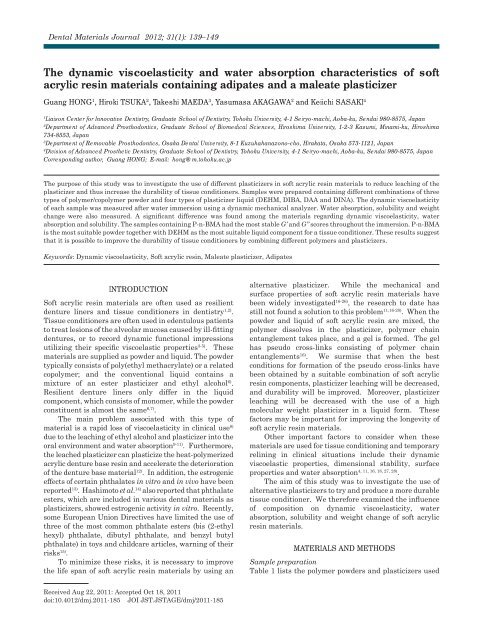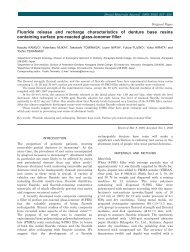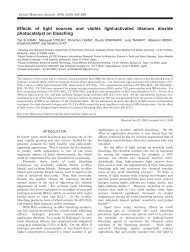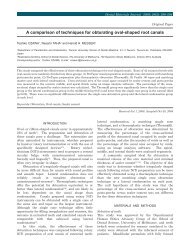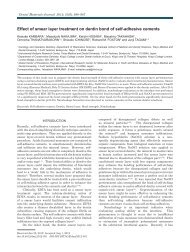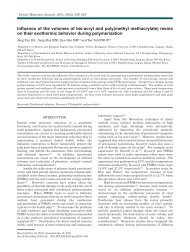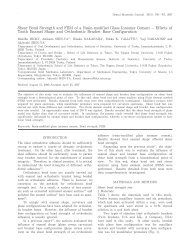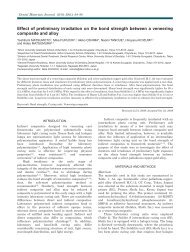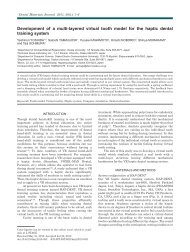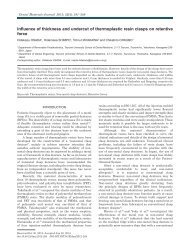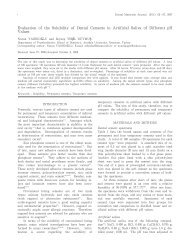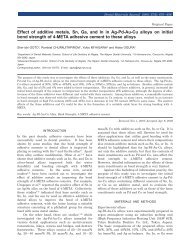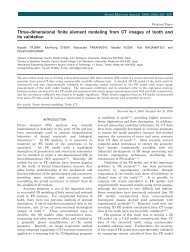The dynamic viscoelasticity and water absorption characteristics of ...
The dynamic viscoelasticity and water absorption characteristics of ...
The dynamic viscoelasticity and water absorption characteristics of ...
You also want an ePaper? Increase the reach of your titles
YUMPU automatically turns print PDFs into web optimized ePapers that Google loves.
Dental Materials Journal 2012; 31(1): 139–149<br />
<strong>The</strong> <strong>dynamic</strong> <strong>viscoelasticity</strong> <strong>and</strong> <strong>water</strong> <strong>absorption</strong> <strong>characteristics</strong> <strong>of</strong> s<strong>of</strong>t<br />
acrylic resin materials containing adipates <strong>and</strong> a maleate plasticizer<br />
Guang HONG 1 , Hiroki TSUKA 2 , Takeshi MAEDA 3 , Yasumasa AKAGAWA 2 <strong>and</strong> Keiichi SASAKI 4<br />
1<br />
Liaison Center for Innovative Dentistry, Graduate School <strong>of</strong> Dentistry, Tohoku University, 4-1 Seiryo-machi, Aoba-ku, Sendai 980-8575, Japan<br />
2<br />
Department <strong>of</strong> Advanced Prosthodontics, Graduate School <strong>of</strong> Biomedical Sciences, Hiroshima University, 1-2-3 Kasumi, Minami-ku, Hiroshima<br />
734-8553, Japan<br />
3<br />
Department <strong>of</strong> Removable Prosthodontics, Osaka Dental University, 8-1 Kuzuhahanazono-cho, Hirakata, Osaka 573-1121, Japan<br />
4<br />
Division <strong>of</strong> Advanced Prosthetic Dentistry, Graduate School <strong>of</strong> Dentistry, Tohoku University, 4-1 Seiryo-machi, Aoba-ku, Sendai 980-8575, Japan<br />
Corresponding author, Guang HONG; E-mail: hong@m.tohoku.ac.jp<br />
<strong>The</strong> purpose <strong>of</strong> this study was to investigate the use <strong>of</strong> different plasticizers in s<strong>of</strong>t acrylic resin materials to reduce leaching <strong>of</strong> the<br />
plasticizer <strong>and</strong> thus increase the durability <strong>of</strong> tissue conditioners. Samples were prepared containing different combinations <strong>of</strong> three<br />
types <strong>of</strong> polymer/copolymer powder <strong>and</strong> four types <strong>of</strong> plasticizer liquid (DEHM, DIBA, DAA <strong>and</strong> DINA). <strong>The</strong> <strong>dynamic</strong> <strong>viscoelasticity</strong><br />
<strong>of</strong> each sample was measured after <strong>water</strong> immersion using a <strong>dynamic</strong> mechanical analyzer. Water <strong>absorption</strong>, solubility <strong>and</strong> weight<br />
change were also measured. A significant difference was found among the materials regarding <strong>dynamic</strong> <strong>viscoelasticity</strong>, <strong>water</strong><br />
<strong>absorption</strong> <strong>and</strong> solubility. <strong>The</strong> samples containing P-n-BMA had the most stable G’ <strong>and</strong> G’’ scores throughout the immersion. P-n-BMA<br />
is the most suitable powder together with DEHM as the most suitable liquid component for a tissue conditioner. <strong>The</strong>se results suggest<br />
that it is possible to improve the durability <strong>of</strong> tissue conditioners by combining different polymers <strong>and</strong> plasticizers.<br />
Keywords: Dynamic <strong>viscoelasticity</strong>, S<strong>of</strong>t acrylic resin, Maleate plasticizer, Adipates<br />
INTRODUCTION<br />
S<strong>of</strong>t acrylic resin materials are <strong>of</strong>ten used as resilient<br />
denture liners <strong>and</strong> tissue conditioners in dentistry 1,2) .<br />
Tissue conditioners are <strong>of</strong>ten used in edentulous patients<br />
to treat lesions <strong>of</strong> the alveolar mucosa caused by ill-fitting<br />
dentures, or to record <strong>dynamic</strong> functional impressions<br />
utilizing their specific viscoelastic properties 3-5) . <strong>The</strong>se<br />
materials are supplied as powder <strong>and</strong> liquid. <strong>The</strong> powder<br />
typically consists <strong>of</strong> poly(ethyl methacrylate) or a related<br />
copolymer; <strong>and</strong> the conventional liquid contains a<br />
mixture <strong>of</strong> an ester plasticizer <strong>and</strong> ethyl alcohol 6) .<br />
Resilient denture liners only differ in the liquid<br />
component, which consists <strong>of</strong> monomer, while the powder<br />
constituent is almost the same 6,7) .<br />
<strong>The</strong> main problem associated with this type <strong>of</strong><br />
material is a rapid loss <strong>of</strong> <strong>viscoelasticity</strong> in clinical use 8)<br />
due to the leaching <strong>of</strong> ethyl alcohol <strong>and</strong> plasticizer into the<br />
oral environment <strong>and</strong> <strong>water</strong> <strong>absorption</strong> 9-11) . Furthermore,<br />
the leached plasticizer can plasticize the heat-polymerized<br />
acrylic denture base resin <strong>and</strong> accelerate the deterioration<br />
<strong>of</strong> the denture base material 12) . In addition, the estrogenic<br />
effects <strong>of</strong> certain phthalates in vitro <strong>and</strong> in vivo have been<br />
reported 13) . Hashimoto et al. 14) also reported that phthalate<br />
esters, which are included in various dental materials as<br />
plasticizers, showed estrogenic activity in vitro. Recently,<br />
some European Union Directives have limited the use <strong>of</strong><br />
three <strong>of</strong> the most common phthalate esters (bis (2-ethyl<br />
hexyl) phthalate, dibutyl phthalate, <strong>and</strong> benzyl butyl<br />
phthalate) in toys <strong>and</strong> childcare articles, warning <strong>of</strong> their<br />
risks 15) .<br />
To minimize these risks, it is necessary to improve<br />
the life span <strong>of</strong> s<strong>of</strong>t acrylic resin materials by using an<br />
alternative plasticizer. While the mechanical <strong>and</strong><br />
surface properties <strong>of</strong> s<strong>of</strong>t acrylic resin materials have<br />
been widely investigated 16-26) , the research to date has<br />
still not found a solution to this problem 11,16-20) . When the<br />
powder <strong>and</strong> liquid <strong>of</strong> s<strong>of</strong>t acrylic resin are mixed, the<br />
polymer dissolves in the plasticizer, polymer chain<br />
entanglement takes place, <strong>and</strong> a gel is formed. <strong>The</strong> gel<br />
has pseudo cross-links consisting <strong>of</strong> polymer chain<br />
entanglements 16) . We surmise that when the best<br />
conditions for formation <strong>of</strong> the pseudo cross-links have<br />
been obtained by a suitable combination <strong>of</strong> s<strong>of</strong>t acrylic<br />
resin components, plasticizer leaching will be decreased,<br />
<strong>and</strong> durability will be improved. Moreover, plasticizer<br />
leaching will be decreased with the use <strong>of</strong> a high<br />
molecular weight plasticizer in a liquid form. <strong>The</strong>se<br />
factors may be important for improving the longevity <strong>of</strong><br />
s<strong>of</strong>t acrylic resin materials.<br />
Other important factors to consider when these<br />
materials are used for tissue conditioning <strong>and</strong> temporary<br />
relining in clinical situations include their <strong>dynamic</strong><br />
viscoelastic properties, dimensional stability, surface<br />
properties <strong>and</strong> <strong>water</strong> <strong>absorption</strong> 4, 11, 16, 18, 27, 28) .<br />
<strong>The</strong> aim <strong>of</strong> this study was to investigate the use <strong>of</strong><br />
alternative plasticizers to try <strong>and</strong> produce a more durable<br />
tissue conditioner. We therefore examined the influence<br />
<strong>of</strong> composition on <strong>dynamic</strong> <strong>viscoelasticity</strong>, <strong>water</strong><br />
<strong>absorption</strong>, solubility <strong>and</strong> weight change <strong>of</strong> s<strong>of</strong>t acrylic<br />
resin materials.<br />
MATERIALS AND METHODS<br />
Sample preparation<br />
Table 1 lists the polymer powders <strong>and</strong> plasticizers used<br />
Received Aug 22, 2011: Accepted Oct 18, 2011<br />
doi:10.4012/dmj.2011-185 JOI JST.JSTAGE/dmj/2011-185
140<br />
Dent Mater J 2012; 31(1): 139–149<br />
Table 1<br />
Polymer powders <strong>and</strong> plasticizers used<br />
Polymer Code M w P s<br />
Polyethyl methacrylate PEMA 3.39×10 5 20 µm<br />
Poly(n-butyl methacrylate) P-n-BMA 3.68×10 5 200 µm<br />
Copoly (n-butyl/i-butyl methacrylate)<br />
P-n-BMA/i-BMA<br />
(composition ratio: 4/6)<br />
1.99×10 5 200 µm<br />
Plasticizer Code M w CAS No.<br />
Di(2-ethylhexyl) maleate DEHM 340.5 142-16-5<br />
Diisobutyl adipate DIBA 258.4 141-04-8<br />
Di-n-alkyl adipate (C=6,8,10) DAA 370.4 106-19-4<br />
Diisononyl adipate DINA 398.6 33703-08-1<br />
Ethyl alcohol EtOH 46.1 64-17-5<br />
M w: average molecular weight; Ps: particle size<br />
Table 2 Formulations components<br />
Code Powders Liquids P/L by weight<br />
PEMA+DEHM PEMA 100wt% DEHM 95wt%+EtOH 5wt% 1.35<br />
PEMA+DIBA PEMA 100wt% DIBA 95wt%+EtOH 5wt% 1.35<br />
PEMA+DAA PEMA 100wt% DAA 95wt%+EtOH 5wt% 1.35<br />
PEMA+DINA PEMA 100wt% DINA 95wt%+EtOH 5wt% 1.35<br />
P-n-BMA+DEHM P-n-BMA 100wt% DEHM 95wt%+EtOH 5wt% 1.35<br />
P-n-BMA+DIBA P-n-BMA 100wt% DIBA 95wt%+EtOH 5wt% 1.35<br />
P-n-BMA+DAA P-n-BMA 100wt% DAA 95wt%+EtOH 5wt% 1.35<br />
P-n-BMA+DINA P-n-BMA 100wt% DINA 95wt%+EtOH 5wt% 1.35<br />
P-n-BMA/i-BMA+DEHM P-n-BMA/i-BMA 100wt% DEHM 95wt%+EtOH 5wt% 1.35<br />
P-n-BMA/i-BMA+DIBA P-n-BMA/i-BMA 100wt% DIBA 95wt%+EtOH 5wt% 1.35<br />
P-n-BMA/i-BMA+DAA P-n-BMA/i-BMA 100wt% DAA 95wt%+EtOH 5wt% 1.35<br />
P-n-BMA/i-BMA+DINA P-n-BMA/i-BMA 100wt% DINA 95wt%+EtOH 5wt% 1.35<br />
in this study. Three polymer powders (Negami Chemical<br />
Industrial Co., LTD., Ishikawa, Japan); one polyethyl<br />
methacrylate (PEMA), one poly(n-butyl methacrylate)<br />
(P-n-BMA) <strong>and</strong> one copoly(n-butyl/i-butyl methacrylate)<br />
(P-n-BMA/i-BMA) were used in powder form. Four<br />
plasticizers (Tokyo Chemical Industry Co., LTD., Tokyo,<br />
Japan); one maleate plasticizer; di (2-ethylhexyl) maleate<br />
(DEHM), three adipate plasticizers; diisobutyl adipate<br />
(DIBA), di-n-alkyl adipate (DAA) <strong>and</strong> diisononyl adipate<br />
(DINA); <strong>and</strong> ethyl alcohol (EtOH) (Wako Pure Chemical<br />
Industries Ltd., Osaka, Japan) were used in liquid form.<br />
<strong>The</strong> 12 formulations used in this study <strong>and</strong> the<br />
powder/liquid (P/L) ratio are listed in Table 2. <strong>The</strong><br />
powder <strong>and</strong> liquid were mixed by h<strong>and</strong> for 2 min (at<br />
23±2°C <strong>and</strong> 70% humidity), <strong>and</strong> then poured into a<br />
poly(propylene) container. Glass plates were placed on<br />
top <strong>of</strong> the containers <strong>and</strong> the containers were placed in a<br />
37°C incubator for 30 min. After the incubation, the<br />
specimens were removed from the polypropylene<br />
containers <strong>and</strong> immersed in 100 mL distilled <strong>water</strong> in<br />
dark brown containers at 37°C.<br />
Dynamic <strong>viscoelasticity</strong> measurement<br />
Five pairs <strong>of</strong> specimens <strong>of</strong> each formulation were<br />
prepared in layers measuring 10×10×2 mm. <strong>The</strong><br />
<strong>dynamic</strong> <strong>viscoelasticity</strong> was measured using an<br />
automatic <strong>dynamic</strong> mechanical analyzer (DMA Q800,<br />
TA Instruments Co., New Castle, USA) (Fig. 1) at 37°C<br />
with the use <strong>of</strong> a shear s<strong>and</strong>wich sample clamp at 0 (30<br />
min after specimen preparation), 1, 3, 7, <strong>and</strong> 14 days<br />
after immersion in distilled <strong>water</strong>. This device is based<br />
on the principle <strong>of</strong> non-resonance-forced vibration <strong>and</strong><br />
consists <strong>of</strong> a measurement operation block, furnace,<br />
sample clamps, <strong>and</strong> main unit. <strong>The</strong> measurement<br />
operation block consists <strong>of</strong> an optical encoder, air<br />
bearings <strong>and</strong> driver motor. Viscoelasticity is studied<br />
using <strong>dynamic</strong> mechanical analysis where an oscillatory<br />
force (stress) is applied to a material <strong>and</strong> the resulting<br />
displacement (strain) is measured. During testing a<br />
suitable shear <strong>and</strong> <strong>dynamic</strong> displacement are applied to<br />
the specimen, <strong>and</strong> the shear storage modulus (G’), shear<br />
loss modulus (G’’) <strong>and</strong> loss tangent (tan ) are detected.<br />
In this study, the G’, G’’ <strong>and</strong> tan were determined over<br />
a frequency range <strong>of</strong> 0.05–100 Hz with a 0.08% strain.<br />
Figure 2 shows the schemata <strong>of</strong> relationship between
Dent Mater J 2012; 31(1): 139–149 141<br />
Fig. 1<br />
Block diagram <strong>of</strong> the automatic <strong>dynamic</strong> mechanical analyzer (DMA Q800).<br />
Fig. 2<br />
Schematic <strong>of</strong> relationship between stress <strong>and</strong> strain.
142<br />
Dent Mater J 2012; 31(1): 139–149<br />
stress <strong>and</strong> strain. In purely elastic materials (a), the<br />
stress <strong>and</strong> strain occur in phase, so that the response <strong>of</strong><br />
one occurs simultaneously with the other. In purely<br />
viscous materials (b), there is a phase difference between<br />
stress <strong>and</strong> strain, where strain lags stress by a 90° (/2<br />
radian) phase lag. Viscoelastic materials (c) exhibit<br />
behavior somewhere in between that <strong>of</strong> purely viscous<br />
<strong>and</strong> purely elastic materials, exhibiting some phase lag<br />
in strain. <strong>The</strong> shear storage modulus (G’) in viscoelastic<br />
materials measures the stored energy, representing the<br />
elastic portion; <strong>and</strong> the shear loss modulus (G’’) in<br />
viscoelastic materials measures the energy dissipated as<br />
heat, representing the viscous portion. <strong>The</strong> loss tangent<br />
(tan ) is a useful parameter <strong>and</strong> a measure <strong>of</strong> the ratio<br />
<strong>of</strong> energy dissipated to energy stored.<br />
Water <strong>absorption</strong>, solubility, <strong>and</strong> weight change<br />
measurement<br />
Five specimens <strong>of</strong> each formulation were prepared in<br />
layers measuring 30×20×2 mm. <strong>The</strong> samples were<br />
weighed using an analytical balance (AW220, Shimadzu<br />
Co., Kyoto, Japan) to an accuracy <strong>of</strong> 0.001 g at 30 min<br />
after sample preparation, <strong>and</strong> then after 1, 3, 7, <strong>and</strong> 14<br />
days <strong>of</strong> immersion. After 14 days <strong>of</strong> immersion, the<br />
samples were removed from the <strong>water</strong> <strong>and</strong> stored in<br />
desiccators containing freshly dried silica gel at 23°C.<br />
<strong>The</strong> weight measurement was repeated every day until a<br />
constant mass was obtained, i.e. until the loss in mass <strong>of</strong><br />
each specimen was no more than 0.0002 g between<br />
successive 2 days weightings. <strong>The</strong> <strong>water</strong> <strong>absorption</strong><br />
(W sp), solubility (W sl) <strong>and</strong> weight change (W ch) <strong>of</strong> the<br />
samples were expressed as a percentage using the<br />
following formulae:<br />
W sp (%)=(M 2−M 3)×100/M 1<br />
W sl (%)=(M 1−M 3)×100/M 1<br />
W ch (%)=(M−M 1)×100/M 1<br />
where M 1 is the initial weight <strong>of</strong> the materials before<br />
immersion in <strong>water</strong> (after sample preparation), M 2 is the<br />
weight after <strong>absorption</strong> <strong>and</strong> desorption, M 3 is the final<br />
weight after desiccation, <strong>and</strong> M is the weight <strong>of</strong> the<br />
materials after 1, 3, 7, <strong>and</strong> 14 days <strong>of</strong> immersion.<br />
Statistical analysis<br />
All data, consisting <strong>of</strong> <strong>dynamic</strong> <strong>viscoelasticity</strong> (G’, G’’ <strong>and</strong><br />
tan ), <strong>water</strong> <strong>absorption</strong>, solubility <strong>and</strong> weight change<br />
data, were analyzed independently by one-way analysis<br />
<strong>of</strong> variance (ANOVA) combined with a Student-Newman-<br />
Keuls (SNK) multiple comparison test at a 5% level <strong>of</strong><br />
significance. Two-way ANOVA was used to determine<br />
the influence <strong>of</strong> the composition <strong>and</strong> immersion time on<br />
the <strong>dynamic</strong> <strong>viscoelasticity</strong>, <strong>water</strong> <strong>absorption</strong>, solubility<br />
<strong>and</strong> weight change <strong>of</strong> the materials. A frequency <strong>of</strong> 1 Hz<br />
was selected for statistical analyses. <strong>The</strong> differences<br />
among materials <strong>and</strong> among immersion times were<br />
tested with an SNK test at a 5% level <strong>of</strong> significance. All<br />
analyses were computed with SPSS for the Windows<br />
operating system (SPSS 12, SPSS Japan Inc., Tokyo,<br />
Japan).<br />
RESULTS<br />
Figures 3, 4 <strong>and</strong> 5 show the dependence <strong>of</strong> G’, G’’ <strong>and</strong> tan<br />
on frequency for the each formulation 30 min after<br />
specimen preparation. All samples exhibited higher<br />
values <strong>of</strong> G’ <strong>and</strong> G’’ at higher frequencies excepted G’<br />
values <strong>of</strong> samples <strong>of</strong> containing P-n-BMA. G’ <strong>of</strong> samples<br />
<strong>of</strong> containing P-n-BMA increased as the frequency<br />
increased from 0.05 to 10 Hz, then decreased again at<br />
higher frequencies. <strong>The</strong> tan <strong>of</strong> all samples decreased as<br />
the frequency increased from 0.05 to 10 Hz, then<br />
increased again at higher frequencies.<br />
Table 3 shows the mean <strong>and</strong> st<strong>and</strong>ard deviations<br />
(SD) <strong>of</strong> the storage modulus (G’), loss modulus (G’’) <strong>and</strong><br />
loss tangent (tan ) <strong>of</strong> each formulation at 1 Hz before<br />
immersion. Significant differences were found between<br />
the different materials (p
Dent Mater J 2012; 31(1): 139–149 143<br />
Fig. 3<br />
Variation <strong>of</strong> storage modulus (G’) with frequency <strong>of</strong> materials 30 min after specimen preparation.<br />
Fig. 4<br />
Variation <strong>of</strong> loss modulus (G’’) with frequency <strong>of</strong> materials 30 min after specimen preparation.
144<br />
Dent Mater J 2012; 31(1): 139–149<br />
Fig. 5<br />
Variation <strong>of</strong> loss tangent (tan ) with frequency <strong>of</strong> materials 30 min after specimen preparation.<br />
Table 3 Initial storage modulus (G’), loss modulus (G’’) <strong>and</strong> loss tangent (tan ) <strong>of</strong> each formulation at 1 Hz<br />
Code G’ (MPa) G’’ (MPa) tan <br />
PEMA+DEHM 0.0714 (0.0085) a 0.0151 (0.0016) b 0.21 (0.004) g<br />
PEMA+DIBA 0.0494 (0.0058) c 0.0105 (0.0012) cd 0.21 (0.002) g<br />
PEMA+DAA 0.0610 (0.0103) b 0.0129 (0.0021) c 0.21 (0.003) g<br />
PEMA+DINA 0.0626 (0.0085) b 0.0181 (0.0022) a 0.29 (0.013) f<br />
P-n-BMA+DEHM 0.0106 (0.0007) de 0.0043 (0.0002) f 0.41 (0.004) e<br />
P-n-BMA+DIBA 0.0115 (0.0009) de 0.0057 (0.0003) f 0.50 (0.012) c<br />
P-n-BMA+DAA 0.0118 (0.0017) de 0.0055 (0.0007) f 0.47 (0.008) d<br />
P-n-BMA+DINA 0.0118 (0.0011) de 0.0049 (0.0005) f 0.42 (0.009) e<br />
P-n-BMA/i-BMA+DEHM 0.0182 (0.0020) de 0.0103 (0.0009) e 0.57 (0.019) b<br />
P-n-BMA/i-BMA+DIBA 0.0085 (0.0032) e 0.0057 (0.0018) f 0.69 (0.049) a<br />
P-n-BMA/i-BMA+DAA 0.0195 (0.0012) de 0.0109 (0.0005) cd 0.56 (0.027) b<br />
P-n-BMA/i-BMA+DINA 0.0202 (0.0022) d 0.0111 (0.0009) cd 0.55 (0.015) b<br />
Identical letters indicate no significant differences (p>0.05, SNK test)<br />
recorded higher W sp <strong>and</strong> W sl values than samples<br />
containing other plasticizers.<br />
Weight changes with time for each formulation are<br />
shown in Fig. 9. <strong>The</strong> ANOVA results indicate significant<br />
differences among the materials <strong>and</strong> significant effects <strong>of</strong><br />
immersion time on weight change (p
Dent Mater J 2012; 31(1): 139–149 145<br />
Fig. 6<br />
Variations in storage modulus (G’) with immersion period at 1 Hz.<br />
Fig. 7<br />
Variations in loss modulus (G’’) with immersion period at 1 Hz.
146<br />
Dent Mater J 2012; 31(1): 139–149<br />
Fig. 8<br />
Variations in loss tangent (tan ) with immersion period at 1 Hz.<br />
Table 4 Water <strong>absorption</strong> <strong>and</strong> solubility <strong>of</strong> each formulation<br />
Code Water <strong>absorption</strong> (%) Solubility (%)<br />
PEMA+DEHM 4.08 (0.17) d 1.52 (0.11) a<br />
PEMA+DIBA 5.88 (0.67) e 6.40 (0.64) c<br />
PEMA+DAA 4.09 (0.28) d 1.91 (0.28) a<br />
PEMA+DINA 4.08 (0.33) d 2.26 (0.32) a<br />
P-n-BMA+DEHM 1.26 (0.39) a 1.89 (0.26) a<br />
P-n-BMA+DIBA 4.35 (0.62) d 7.52 (0.36) d<br />
P-n-BMA+DAA 2.80 (1.03) c 2.09 (0.07) a<br />
P-n-BMA+DINA 1.79 (0.97) abc 1.84 (0.19) a<br />
P-n-BMA/i-BMA+DEHM 1.82 (0.27) abc 1.52 (0.13) a<br />
P-n-BMA/i-BMA+DIBA 4.11 (0.65) d 5.60 (0.84) b<br />
P-n-BMA/i-BMA+DAA 1.52 (0.03) ab 1.78 (0.19) a<br />
P-n-BMA/i-BMA+DINA 2.58 (0.75) bc 1.65 (0.28) a<br />
Identical letters indicate no significant differences. (p>0.05, SNK test)<br />
DISCUSSION<br />
<strong>The</strong> longevity <strong>of</strong> tissue conditioners is a significant<br />
problem in prosthodontics 8) , <strong>and</strong> <strong>viscoelasticity</strong> is one <strong>of</strong><br />
the most important factors for determining their clinical<br />
acceptance 13,14) . In clinical situations, tissue conditioners<br />
are <strong>of</strong>ten replaced every three to four days 29) , <strong>and</strong> they<br />
rarely last beyond two weeks. <strong>The</strong>refore, in this study,<br />
our samples were tested for two weeks. Dynamic<br />
viscoelastic parameters at 1 Hz were selected for<br />
evaluation in this study based on the research <strong>of</strong> Murata<br />
et al. 11) who reported that these settings would simulate<br />
behavior under typical masticatory conditions. <strong>The</strong><br />
shear storage modulus (G’) represents the elastic<br />
component <strong>of</strong> material behavior, <strong>and</strong> the shear loss<br />
modulus (G’’) represents the viscous component <strong>of</strong>
Dent Mater J 2012; 31(1): 139–149 147<br />
Fig. 9<br />
Weight change with time for each formulation.<br />
material behavior. <strong>The</strong> lower G’ <strong>and</strong> higher G’’ means<br />
that material has good flow <strong>characteristics</strong>, which would<br />
allow the damaged denture-bearing mucosa to recover to<br />
a healthy state <strong>and</strong> record the shape <strong>of</strong> the mucosa under<br />
functional stress more effectively.<br />
Differences in <strong>dynamic</strong> viscoelastic behavior were<br />
found among the materials. <strong>The</strong> viscoelastic properties<br />
<strong>of</strong> the all samples showed sensitivity to the changed in<br />
frequency. <strong>The</strong> G’ describes elastic deformation under<br />
stress whilst the G’’ describes viscous deformations. <strong>The</strong><br />
butyl system polymer based samples exhibited lower G’<br />
<strong>and</strong> G’’, <strong>and</strong> higher tan than ethyl system polymer<br />
based samples. This suggests that the butyl system<br />
polymer based samples have good flow properties, which<br />
would allow the damaged denture-bearing mucosa to<br />
recover to a healthy state <strong>and</strong> more effectively record the<br />
shape <strong>of</strong> the mucosa under functional stress. <strong>The</strong> glass<br />
transition temperature (T g) <strong>of</strong> poly(ethyl methacrylate)<br />
is higher than room temperature 16) , while the T g <strong>of</strong><br />
poly(n-butyl methacrylate) <strong>and</strong> related copolymers is<br />
near or below room temperature 16) . For this reason, the<br />
G’ <strong>and</strong> G’’ <strong>of</strong> samples containing P-n-BMA <strong>and</strong> P-n-BMA/<br />
i-BMA are lower than those <strong>of</strong> the PEMA based samples.<br />
<strong>The</strong> P-n-BMA samples exhibited the most stable <strong>dynamic</strong><br />
viscoelastic <strong>characteristics</strong> (G’ <strong>and</strong> G’’) throughout the<br />
experimental period <strong>of</strong> all the materials except the<br />
P-n-BMA+DIBA samples. Tissue conditioners are used<br />
for three main clinical purposes: tissue conditioning;<br />
<strong>dynamic</strong> impressions; <strong>and</strong> temporary relining. Murata<br />
et al. 30) reported that materials with good early flow<br />
properties, <strong>and</strong> a lower rate <strong>of</strong> change <strong>of</strong> flow with the<br />
passage <strong>of</strong> time are suitable for tissue conditioning.<br />
<strong>The</strong>refore, s<strong>of</strong>t acrylic resins containing P-n-BMA are<br />
probably the most suitable for tissue conditioning.<br />
<strong>The</strong> samples containing P-n-BMA/i-BMA, except for<br />
the P-n-BMA/i-BMA+DIBA samples, exhibited rapid<br />
changes in G’, G’’ <strong>and</strong> tan during the first day <strong>of</strong> <strong>water</strong><br />
immersion. Jones et al. 9) reported that the a total <strong>of</strong><br />
between 26–52% <strong>of</strong> the alcohol content <strong>of</strong> the gel<br />
materials was lost during the various stages <strong>of</strong><br />
preparation prior to conducting the test. And he also<br />
reported that the alcohol is completely lost within 24 h<br />
from polymer gel materials stored in <strong>water</strong>. Supporting<br />
these findings, Wilson 10) reported that most alcohol was<br />
lost within the first 12 h. Based on these reports, we<br />
suggest that the alcohol loss might be the reason for this<br />
rapid changes in rheological parameters recorded during<br />
the first day.<br />
<strong>The</strong> samples containing P-n-BMA, except for the<br />
P-n-BMA+DIBA samples, showed the most stability<br />
coupled with a low change rate <strong>of</strong> G’ <strong>and</strong> G’’. Several<br />
investigators have reported on the leachability <strong>of</strong><br />
plasticizers from s<strong>of</strong>t dental polymers 6, 9, 32) . <strong>The</strong> loss <strong>of</strong><br />
<strong>viscoelasticity</strong> in tissue conditioners in clinical use may<br />
be due to the leaching out <strong>of</strong> the plasticizer from the s<strong>of</strong>t<br />
polymer gel material, accompanied by <strong>water</strong> <strong>absorption</strong>.<br />
<strong>The</strong> absorbed <strong>water</strong> also acts as a plasticizer, reducing<br />
the mechanical properties <strong>of</strong> the polymer network 33) .
148<br />
Dent Mater J 2012; 31(1): 139–149<br />
<strong>The</strong> samples containing P-n-BMA, except for the<br />
P-n-BMA+DIBA samples, recorded lower values for<br />
<strong>water</strong> <strong>absorption</strong> <strong>and</strong> solubility. This could be the reason<br />
why these samples also showed the most stable<br />
<strong>viscoelasticity</strong>. However, another reason for this<br />
viscoelastic stability could be that these samples<br />
constitute the most suitable combination <strong>of</strong> components,<br />
providing the best conditions for the optimal formation<br />
<strong>of</strong> the pseudo cross-links consisting <strong>of</strong> polymer chain<br />
entanglements 24,34) .<br />
When s<strong>of</strong>t acrylic resin materials are immersed into<br />
<strong>water</strong>, two processes take place: plasticizers <strong>and</strong> alcohol<br />
are leached into the <strong>water</strong> <strong>and</strong>, at the same time, <strong>water</strong><br />
is absorbed by the material. In this study, the samples<br />
containing PEMA recorded greater <strong>water</strong> <strong>absorption</strong><br />
than the samples containing other polymers. Samples<br />
containing DIBA as the plasticizer also recorded greater<br />
<strong>water</strong> <strong>absorption</strong> than other samples. <strong>The</strong> relative<br />
hydrophilicity <strong>of</strong> the acrylic resin materials is the major<br />
influence on their <strong>water</strong> <strong>absorption</strong> 31) . <strong>The</strong> hydrophilicity<br />
increased as the number <strong>of</strong> hydrocarbon groups in the<br />
polymers or plasticizers decreased. PEMA has fewer<br />
hydrocarbon groups than P-n-BMA <strong>and</strong> P-n-BMA/i-BMA,<br />
<strong>and</strong> DIBA has fewer hydrocarbon groups than the other<br />
plasticizers used in this study. This could explain this<br />
tendency for higher <strong>water</strong> <strong>absorption</strong>. And the different<br />
molecular weight may be also influenced to these results.<br />
<strong>The</strong> samples containing DIBA as a plasticizer<br />
recorded higher solubility than the other samples. <strong>The</strong><br />
solubility <strong>of</strong> s<strong>of</strong>t acrylic resin materials results from loss<br />
<strong>of</strong> ethanol <strong>and</strong> plasticizer. Jones et al. 9) reported that<br />
higher molecular weight plasticizers did not leach as<br />
much from s<strong>of</strong>t polymer gel materials as lower molecular<br />
weight plasticizers. <strong>The</strong> molecular weights (M w) <strong>of</strong><br />
plasticizers used in this study are 340.5 (DEHM), 370.4<br />
(DAA) <strong>and</strong> 398.6 (DINA), which are higher than DIBA<br />
(M w: 258.4), <strong>and</strong> also higher than those <strong>of</strong> other<br />
plasticizers usually used in commercial tissue<br />
conditioners, such as dibutyl phthalate (M w: 278.4),<br />
benzyl benzoate (M w: 212.3), benzyl salicylate (M w: 228.2)<br />
<strong>and</strong> dibutyl sebacate (M w: 314.5). Based on this<br />
information, we assume that the DIBA samples had a<br />
higher level <strong>of</strong> leaching than the other plasticizers used<br />
in this study, explaining why the DIBA samples exhibited<br />
higher solubility.<br />
All samples containing PEMA, except for the<br />
PEMA+DIBA samples, displayed a significant weight<br />
gain (maximum 2.56%). <strong>The</strong>se samples recorded higher<br />
<strong>water</strong> <strong>absorption</strong> (from 4.08% to 4.09%) than solubility<br />
(from 1.52% to 2.26%). This may be because<br />
P-n-BMA+DEHM samples, P-n-BMA+DINA samples<br />
<strong>and</strong> all samples containing DIBA lost weight during<br />
immersion in <strong>water</strong>, most likely due to the plasticizers<br />
<strong>and</strong> alcohol leaching out at a greater rate than the <strong>water</strong><br />
being absorbed.<br />
<strong>The</strong> results <strong>of</strong> this study indicate that the <strong>dynamic</strong><br />
<strong>viscoelasticity</strong> <strong>and</strong> <strong>water</strong> <strong>absorption</strong> <strong>characteristics</strong> <strong>of</strong><br />
s<strong>of</strong>t acrylic resin materials are greatly influenced by the<br />
combination <strong>of</strong> the components <strong>of</strong> these materials. <strong>The</strong><br />
flow <strong>of</strong> s<strong>of</strong>t acrylic resin materials tended to increase in<br />
resins containing butyl system polymers. <strong>The</strong><br />
P-n-BMA+DEHM sample showed the greatest stability<br />
<strong>and</strong> <strong>dynamic</strong> <strong>viscoelasticity</strong>, <strong>and</strong> the lowest values for<br />
<strong>water</strong> <strong>absorption</strong> <strong>and</strong> solubility. It should be noted,<br />
however, that the present study did not completely<br />
simulate clinical conditions because specimens were<br />
tested for <strong>viscoelasticity</strong> in the dry state, <strong>and</strong> all<br />
specimens were immersed in distilled <strong>water</strong>. To<br />
overcome the limitations <strong>of</strong> the in vitro tests, artificial<br />
saliva should be used as an immersion solution.<br />
Furthermore, for a more complete underst<strong>and</strong>ing <strong>of</strong> how<br />
different components affect durability, further research<br />
is required into the components’ effects on other<br />
properties such as working time, gelation time, surface<br />
properties, dimensional change, <strong>and</strong> leachability <strong>of</strong><br />
plasticizer.<br />
CONCLUSION<br />
From the st<strong>and</strong>point <strong>of</strong> <strong>dynamic</strong> <strong>viscoelasticity</strong> <strong>and</strong><br />
<strong>water</strong> <strong>absorption</strong> <strong>characteristics</strong>, poly(n-butyl<br />
methacrylate) (P-n-BMA) is the most suitable powder<br />
together with di (2-ethylhexyl) maleate (DEHM) as the<br />
most suitable liquid component for a tissue conditioner.<br />
Within the limitations <strong>of</strong> this study, our results show<br />
that it may be possible to improve the durability <strong>of</strong> tissue<br />
conditioners by judicious choice <strong>of</strong> components.<br />
ACKNOWLEDGMENTS<br />
This research was supported by Grant-in-Aid (No<br />
21791899) for Scientific Research from the Ministry <strong>of</strong><br />
Education, Culture, Sports, Science <strong>and</strong> Technology,<br />
Japan.<br />
REFERENCES<br />
1) Roberto von KK. Tissue conditioners. J Prosthet Dent 1971;<br />
25: 244-250.<br />
2) Qudah S, Harrison A, Huggett R. S<strong>of</strong>t lining materials in<br />
prosthetic dentistry: A review. Int J Prosthodont 1990; 3:<br />
477-483.<br />
3) Wilson HJ, Tomlin HR, Osborne J. Tissue conditioners <strong>and</strong><br />
functional impression materials. Br Dent J 1966; 121: 9-16.<br />
4) Harrison A. Temporary s<strong>of</strong>t lining materials: A review <strong>of</strong><br />
their uses. Br Dent J 1981; 151: 419-422.<br />
5) Murata H, Hamada T, Djulaeha E, Nikawa H. Rheology <strong>of</strong><br />
tissue conditioners. J Prosthet Dent 1998; 79: 188-199.<br />
6) Braden M. Tissue conditioners: I. Composition <strong>and</strong> structure.<br />
J Dent Res 1970; 49: 145-148.<br />
7) Wright PS. Composition <strong>and</strong> properties <strong>of</strong> s<strong>of</strong>t lining<br />
materials for acrylic dentures. J Dent 1981; 9: 210-223.<br />
8) Jepson NJA, McCabe JF, Storer R. Age changes in the<br />
<strong>viscoelasticity</strong> <strong>of</strong> a temporary s<strong>of</strong>t lining material. J Dent<br />
1993; 21: 244-247.<br />
9) Jones DW, Sutow EJ, Hall GC, Tobin WM, Graham BS.<br />
Dental s<strong>of</strong>t polymers: plasticizer composition <strong>and</strong> leachability.<br />
Dent Mater 1988; 4: 1-7.<br />
10) Wilson J. In vitro loss <strong>of</strong> alcohol from tissue conditioners. Int<br />
J Prosthodont 1992; 5: 17-21.<br />
11) Murata H, Narasaki Y, Hamada T, McCabe JF. An alcolholfree<br />
tissue conditioner —A laboratory evaluation. J Dent<br />
2006; 34: 307-315.
Dent Mater J 2012; 31(1): 139–149 149<br />
12) Murata H, Toki K, Hong G, Hamada T. Effect <strong>of</strong> tissue<br />
conditioners on the <strong>dynamic</strong> viscoelastic properties <strong>of</strong> a heatpolymerized<br />
denture base. J Prosthet Dent 2002; 88: 409-414.<br />
13) vom Saal FS, Cooke PS, Buchanan DL, Palanza P, Thayer<br />
KA, Nagel SC, Parmigiani S, Welshons WV. A physiologically<br />
based approach to the study <strong>of</strong> bisphenol <strong>and</strong> other estrogenic<br />
chemicals on the size <strong>of</strong> reproductive organs, Daily sperm<br />
production <strong>and</strong> behavior. Toxicol Ind Health 1998; 14:<br />
239-260.<br />
14) Hashimoto Y, Kawaguchi M, Miyazaki K, Nakamura M.<br />
Estrogenic activity <strong>of</strong> tissue conditioners in vitro. Dent Mater<br />
2003; 19: 341-346.<br />
15) Cederberg I. Information from KEMI; Swedish Chemicals<br />
Inspectorate: Sundbyberg, Sweden, 2005. p13.<br />
16) Parker S, Braden M. Formulation <strong>of</strong> tissue conditioners.<br />
Biomaterials 1990; 11: 579-584.<br />
17) Parker S, Braden M. Effect <strong>of</strong> composition on the gelation <strong>of</strong><br />
tissue conditioners. Biomaterials 1996; 17: 1827-1832.<br />
18) Parker S, Martin D, Braden M. S<strong>of</strong>t acrylic resin materials<br />
containing a polymerisable plasticiser I: mechanical<br />
properties. Biomaterials 1998; 19: 1695-1701.<br />
19) Parker S, Martin D, Braden M. S<strong>of</strong>t acrylic resin materials<br />
containing a polymerisable plasticiser II: Water <strong>absorption</strong><br />
<strong>characteristics</strong>. Biomaterials 1999; 20: 55-60.<br />
20) Hong G, Maeda T, Li YA, Sadamori S, Hamada T, Murata H.<br />
Effect <strong>of</strong> PMMA polymer on the <strong>dynamic</strong> <strong>viscoelasticity</strong> <strong>and</strong><br />
plasticizer leachability <strong>of</strong> PEMA-based tissue conditioners.<br />
Dent Mater J 2010; 29: 374-380.<br />
21) Jepson NJA, McGill JT, McCabe JF. Influence <strong>of</strong> dietary<br />
simulating solvent on the viscelasticity <strong>of</strong> temporary s<strong>of</strong>t<br />
lining materials. J Prosthet Dent 2000; 83: 25-31.<br />
22) Parker S, Braden M. <strong>The</strong> effect <strong>of</strong> particle size on the gelation<br />
<strong>of</strong> tissue conditioners. Biomaterials 2001; 22: 2039-2042.<br />
23) Hong G, Murata H, Hamada T. Relationship between<br />
plasticizer content <strong>and</strong> tensile bond strength <strong>of</strong> s<strong>of</strong>t denture<br />
liners to a denture base resin. Dent Mater J 2004; 23: 94-99.<br />
24) Murata H, Chimori H, Hamada T, McCabe JF. Viscoelasticity<br />
<strong>of</strong> dental tissue conditioners during the sol-gel transition. J<br />
Dent Res 2005; 84: 376-381.<br />
25) Murata H, Hong G, Li YA, Hamada T. Compatibility <strong>of</strong> tissue<br />
conditioners <strong>and</strong> dental stones: Effect on surface roughness. J<br />
Prosthet Dent 2005; 93: 274-281.<br />
26) Hong G, Li YA, Maeda T, Mizumachi W, Sadamori S, Hamada<br />
T, Murata H. Influence <strong>of</strong> storage methods on the surface<br />
roughness <strong>of</strong> tissue conditioner. Dent Mater J 2008; 27:<br />
153-158.<br />
27) Pound E. Conditioning <strong>of</strong> denture patients. J Am Dent Assoc<br />
1962; 64: 461-468.<br />
28) Murata H, McCabe JF, Jepson NJ, Hamada T. <strong>The</strong> influence<br />
<strong>of</strong> immersion solutions on the <strong>viscoelasticity</strong> <strong>of</strong> temporary s<strong>of</strong>t<br />
lining materials. Dent Mater 1996; 12: 19-24.<br />
29) Neill DJ, Nairn RI. Complete denture prosthetics. 2nd ed.<br />
Bristol, Engl<strong>and</strong>: Wright; 1983. p.2-3.<br />
30) Murata H, Hamada T, Taguchi N, Shigeto N, Nikawa H.<br />
Viscoelastic properties <strong>of</strong> tissue conditioners-influence <strong>of</strong><br />
molecular weight <strong>of</strong> polymer powders <strong>and</strong> powder/liquid ratio<br />
<strong>and</strong> the clinical implications. J Oral Rehabil 1998; 25:<br />
621-629.<br />
31) Kalach<strong>and</strong>ra S, Kusy RP. Comparison <strong>of</strong> <strong>water</strong> sorption by<br />
methacrylate <strong>and</strong> dimethacrylate monomers <strong>and</strong> their<br />
corresponding polymers. Polymer 1991; 32: 2428-2434.<br />
32) Graham BS, Jones DW, Sutow EJ. An in vivo <strong>and</strong> in vitro<br />
study <strong>of</strong> the loss <strong>of</strong> plasticizer from s<strong>of</strong>t polymer-gel materials.<br />
J Dent Res 1991; 70: 870-873.<br />
33) Yiu CKY, King NM, Pashley DH, Suh BI, Carvalho RM,<br />
Carriho MRO, Tay FR. Effect <strong>of</strong> resin hydrophilicity <strong>and</strong><br />
<strong>water</strong> storage on resin strength. Biomaterials 2004; 25:<br />
5789-5796.<br />
34) Lodge AS. Elastic liquids. London: Academic Press; 1964.<br />
p.118-119.


